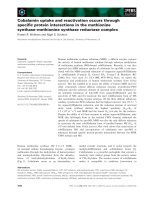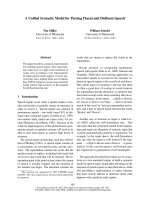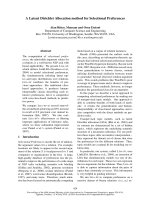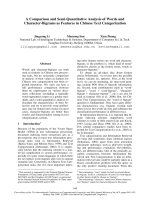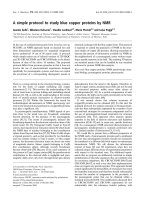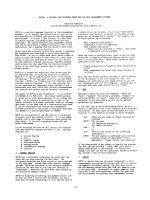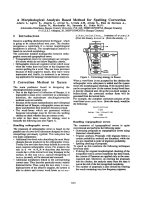Báo cáo khoa học: " A simple and rapid method for detection of Goose Parvovirus in the field by loop-mediated isothermal amplification" pps
Bạn đang xem bản rút gọn của tài liệu. Xem và tải ngay bản đầy đủ của tài liệu tại đây (508.62 KB, 7 trang )
RESEARC H Open Access
A simple and rapid method for detection of
Goose Parvovirus in the field by loop-mediated
isothermal amplification
Yang JinLong
1,2
, Yang Rui
1
, Cheng AnChun
2,3*
, Wang MingShu
2,3
, Fu LiZhi
1
, Yang SongQuan
1
, Zhang SuHui
1
,
Yang Liu
1
, Xu ZhiYong
4
Abstract
Background: Goose parvovirus (GPV) is a Dep endovirus associated with latent infection and mortality in geese.
Currently, in a worldwide scale, GPV severely affects geese production. The objective of this study is to develop a
loop-mediated isothermal amplification (LAMP) method for the sensitive, rapid, and inexpensive detection of GPV
in the field.
Results: A set of six specific primers was designed by targeting the GPV VP3 DNA. With Bst DNA polymerase large
fragment, the target DNA could be amplified at 65°C as early as 20 min of incubation in a simple water bath. A
positive reaction was identified through the detection of the LAMP product by color change visible to the naked
eye. The detection limit of the assay was 28 copies/μl of plasmid pVP3, and with equal sensitivity and specificity to
fluorescent quantitative real-time PCR (FQ-PCR).
Conclusions: The high sensitivity, specificity, and simplicity, as well as the high throughput, make this method
suitable for specific detection of GPV infection in both field conditions and laboratory settings. The utilization of
complicated equipment and conduct of technical training on the GPV LAMP were not necessary.
Background
Goose parvovirus (GPV) is a well known causative agent
of Gosling plague (GP), an acute, contagious, and fatal
disease referred to as Derzsy’s disease [1]. GPV has been
formally classified as a member of the genus Dependo-
virus under the family, Parvoviridae [2]. It was first
described as a clinical entity by Fang [3]. In the realm of
research, GPV has attracted much attention owing to
tremendous economic loss for countries engaged in
industrialized goose production; the virus infection has
spread rapidly worldwide, resulting in high rates of mor-
bidity and mortality [1,4-6].
Several detection methods have been developed for
identifying GPV, such as agar-gel diffusion precipitin
test, virus neutralization (VN) assay, enzyme-linked
immuno sorbent assay (ELISA) [5], qualitative PCR [7,8],
and fluorescent quantitative real-time PCR (FQ-PCR)
[9]. All are effective and accurate in detecting the virus
infection in laboratory settings, but they require the use
of expensive equipment and are laborious and time-con-
suming. Thus, these methods are considered unfavorable
for use on a large-scale basis. In contrast, a more pre-
ferred d etection method would be one that is not only
speedy and sensitive, but also simple and economical
during practical applications [10].
Recently, a loop-mediated isothermal amplification
(LAMP) reaction was developed as an alternative method
to meet the abovementioned requirements. The LAMP
method allows the whole reaction process, including dena-
turing, to proceed at a constant temperature by incubating
the reagents in a simple i ncubator. As a specific nucleic
acid amplification method, it can easily perform and
amplify nucleic acid at isothermal conditions (i.e., 60-65°
C) within 1 h of incubation [11-13]. LAMP reaction
requires four or six primers based on six or eight distinct
regions of the target DNA, hence allowing high degree of
specificity during viral detection. The presence of ampl i-
fied products can be detected at a short time. By the end
* Correspondence:
2
Avian Diseases Research Center, College of Veterinary Medicine of Sichuan
Agricultural University, Yaan 625014, Sichuan Province, China
JinLong et al. Virology Journal 2010, 7:14
/>© 2010 JinLong et al; licensee BioMed Central Ltd. This is an Open Access article distributed under the terms of the Creative Commons
Attribution License ( which permits unrestricted use, distribution, and reproduction in
any medium, provided the original work is properly cited.
of the reaction, the presence or absence of the target DNA
can be judged visually by the appearance of a white preci-
pitate of magnesium pyrophosphate, or a green color of
the solution stained by SYBR green I. The presence of
multiple bands of LAMP reaction products in agarose gel
electrophoresis indicates a mixture composed of stem-
loop DNAs with various sizes of stem and cauliflower-like
structures having multiple loops, which is induced by
alternately annealing inverted repeats of the target
sequence in the same strand [ 11,14]. In addition, t he
LAMP method does not require any special reagent or
sophisticated temperature control device. Since it only
needs simple equipment, cost-effective genetic tests can be
easily achieved. Both simple detection and real-time detec-
tion of the reaction are deemed possible http://loopamp.
eiken.co.jp/e/index.html. Specifical ly, the LAMP met hod
has already been applied in the specific detection of animal
viruses, such as hepatitis B virus [15], Japanese encephali-
tis viral [16], and H9 avian influenza virus [17]. However,
to the best of our knowledge, no study has yet used the
technique to detect GPV. In this study, we report the
development of LAMP assay for the specific, rapid, and
sensitive detection of GPV in infected goslings.
Results
Optimized LAMP reaction
LAMP reaction was performed using plasmid (pVP3)
DNA as temp late in order to determine optimal tem-
perature and t ime of reaction. The a mplicons were
formed at 61, 62, 63, 64, and 65°C and the clearest pro-
duct was detected at 65°C (Fig. 1A). Thus, 65°C was
used as the optimal temperature for the succeeding
assays. Meanwhile, LAMP products were also d etected
as early as 20 min at 65°C (Fig. 1B). Although well-
formed bands in the system could be detected a s early
as 20 min, reaction time was optimized and set at 40
min to ensure positive detection of templates with lower
concentration.
Specificity of the LAMP assay
The specificity of LAMP and FQ-PCR was tested using
templates extracted from GPV and other viruses. Only
GPV showed a positive reaction; no DNA band was
observed from the other seven animal pathogens (Fig.
2). Results of FQ-PCR (data not shown) correlated well
with the LAMP method [9], indicating that LAMP is as
specific as FQ-PCR for GPV detection.
Sensitivity of LAMP assay
The detection limit of LAMP using plasmid DNA was
setat28copies/μl (Fig. 3). In comparison with the
detection limit of FQ-PCR (date not shown) [9], LAMP
was observed to similarly sensitive to the FQ-PCR
system.
Detection of LAMP products by naked eye observation
LAMP products could also be detected with the naked
eye by observing white turbidity in the reacti on mixture
(Fig. 4A) or by color change of the solution stained by
SYBR Green I (Fig. 4B). As shown by Fig. 4A, white tur-
bidity could be o bserved from products of the reaction
with 2.8 × 10
2
to 2.8 × 10
11
copies/μlofplasmid,but
not from the negative control and the 2.8 × 10
0
to 2.8 ×
10
1
copies/μl. In Fi g. 4B, after the addition of 1 μlof
diluted SYBR Green I t o the reaction tube, the color of
the LAMP reaction solution changed from orange to
green in the 2.8 × 10
1
to 2.8 × 10
11
copies/μl of plasmid
template DNA, while no color change was observed in
the 2.8 × 10
0
copies/μl and in the negative control.
These show that the LAMP detection limit could be set
at 2.8 × 10
2
copies/μl to observe white turbidity, and 2.8
×10
1
copies/μl to observe color change in the reaction
solution. The color observation method is 10 times
more sensitive than the white turbidity observ ation
method.
Application of the LAMP assay for detection of GPV
infection in goslings
Optimal LAMP assay was evaluated by analyzing GPV
infected gosling tissues. DNA extracted by the tissue
Figure 1 Determination of the optimal temperature and time of LAMP. (A) Determ ination of the optimal temperature. Lane M: DL-2000
marker; lanes 1: -, negative control; 2–7: LAMP carried out at 60, 61, 62, 63, 64 and 65°C, respectively. (B) Determination of the optimal time. lane
M, DL-2000 marker; lanes 1: -, negative control; 2-7, LAMP carried out for 10, 20, 30, 40, 50 and 60 min, respectively. All the products were
electrophoresed on a 2% agarose gels and stained with ethidium bromide.
JinLong et al. Virology Journal 2010, 7:14
/>Page 2 of 7
boiling method gave rise to a typical ladder pattern, as
shown in Fig. 5. GPV was positively detected in infected
gosling spleen, kidney, and liver (Fig. 5). Thirty clinical
cases with suspecte d GPV infec tions were i nvestigated
using both the LAMP assay and FQ-PCR. Twenty-one
of the 30 samples were tested positive, while nine were
negative, based on FQ-PCR and LAMP, indicating well
concordance between the two methods (data not
shown) when performed on gosling tissues.
Discussion
China currently holds the largest waterfowl population
in the world with a production industry characterized
by increased expansion and rapid development in the
past decades [18]. However, infectious diseases represent
the biggest obstacle to the successful development of
this business. GPV is one of the most serious viral
pathogens in the goose industry. Since preve ntion and
early detection are presently the most logical strategies
for virus control, the most effective way of controlling
the disease would be by conducting routine screening of
this virus [19]. However, thus far, no practica l (e.g., sim-
ple and rapid) method is available for the specific diag-
nosis of GPV in field conditions.
The use of the LAMP reaction has been successfully
established in diagnosing viral infections in human and
animals [15-17]. In the present study, a LAMP protocol
was developed as a rapid and simple detection tool for
the specific diagnosis of GPV. No cross-reaction with
three other related virus (i.e., Aleutian disease virus or
ADV; canine parvovirus or CPV; and porcine parvovirus
or PPV) and four other unr elated animal pathogens (i.e.,
Newcastle disease virus or NDV; Pasteurella multocida,
5:A; Sa lmonella enteritidis, No. 50338; and Escherichia
coli, O78) was observed in the FQ-PCR and LAMP
detection. The specificity of LAMP was not affected by
the presence of non-target genomic DNA in the reac-
tion mixture, a characteristic highly desirable in the
development of a diagnostic system [11]. The LAMP
method used for GPV detection was observed to be
highly sensitive, and other studies have shown that
detection of target DNA by LAMP, compared to FQ-
PCR, was equally sensitive [20,21], a finding confirmed
by our results. In other words, the specificity and the
detection limit of the LAMP assay are equal with F Q-
PCR for detecting GPV.
The optimal condition for detecting GPV b y LAMP
was determined to be at 65°C for 40 min. However, it
was also observed that the LAMP products could be
detected as early as 20 min. In addition, there were
fewer operational steps for the LAMP assay than for
conventional PCR and FQ-PCR assays, and expensive
equipment is not necessary to obtain high level preci-
sion [22]. LAMP i s a more rapid method for detecting
animal virus, as compared to either the PCR or FQ-PCR
method, which separately need at least 2-3 h [23] to
complete. In practice, the time required for diagnosis is
Figure 2 Agarose gel illustrating the specificity of the GPV-
LAMP assay among different species. The reaction was carried
out at 65°C for 40 min. Lane M: DL-2000 marker; lanes 1 and 2: GPV-
CHv and pVP3 as positive control; lane 3:-, negative control; 4: ADV;
5: CPV; 6: PPV; 7: NDV; 8: Pasteurella multocida (5: A); 9: Salmonella
enteritidis (No. 50338); 10: Escherichia coli (O78).
Figure 3 Sensitivities of LAMP for detection of plasmid pVP3. Lane M: DL-2000 marker; 1 –12, reaction car ried out using 10-f old serial
dilutions of plasmid (pVP3) DNA (2.8 × 10
11
copies/μl). 1: 2.8 × 10
0
, 2: 2.8 × 10
1
, 3: 2.8 × 10
2
, 4: 2.8 × 10
3
, 5: 2.8 × 10
4
, 6: 2.8 × 10
5
, 7: 2.8 × 10
6
,
8: 2.8 × 10
7
, 9: 2.8 × 10
8
, 10: 2.8 × 10
9
, 11: 2.8 × 10
10
, 12: 2.8 × 10
11
copies/μl, respectively; lane 13:+, positive control; lane 14:-, negative control.
All the products were electrophoresed on a 2% agarose gels and stained with ethidium bromide.
JinLong et al. Virology Journal 2010, 7:14
/>Page 3 of 7
considered to be crucial for farm and hatchery manage-
ment in goslings breeding. Hence, its rapid characteristic
makes it a useful tool for GPV diagnosis.
Real-time monitoring of LAMP amplification can be
accomplished through agarose gel analysis. LAMP
ampli cons revealed a ladder-like pattern in contrast to a
single band as observed in PCR (Fig. 1). This is due to
the cauliflower-like structures with multiple loops
formed by annealing between alternately inverted
repeats of the target in the same strand [24].
Furthermore, gel electrophoresis is not needed
because the LAMP method synthesizes a large amount
of DNA where the products can be detected by simple
turbidity or fluorescence [17]. Thus, expensive equip-
ment is not necessary to obtain high level precision–one
equivalent to or greater than those of other PCR
techniques. In order to facilitate the field application of
the LAMP assay, the monitoring of amplification can be
accomplished with naked eye inspection through visual
fluorescence. LAMP is a simple and effective method
that utilize SYBR Green I for visu al inspection of ampli-
fication products less t he required use o f gel e lectro-
phoresis and staining with ethidium bromide. The visual
inspection for amplification products could be per-
formed by observing color change following the addition
of 1 μl of SYBR Green I to the tube. The oran ge color
of the dye will change into green under natural light
with posit ive amplification. For cases with no amplifica-
tion, the orange color of the dy e is ret ained [24]. The
sensitivity of inspection by white turbidity was inferior
to the use of SYBR Green I or the electrophoresis
method (Fig. 4A) because tenfo ld more copies of tem-
plate DNA were needed to obtain a positive reaction, as
compared to SYBR Green I or the electrophoresis
method. The eye inspe ction method was simple and
rapid, but offered difficulty in detecting quantitative
amplification. Yet, the eye inspection method could
facilitate the application of LAMP, especially as a field
test [10].
Our final goal is to establish a simple and rapid diag-
nostic method for GPV in field applications. Using
LAMP assay, the only equipment ne eded is a water
bath, which is used for both the DNA preparation and
nucleic acid amplification. With no complicated equip-
ment and the necessary technical training, LAMP assay
is considered very simple and easy to operate. LAMP
can be operated in most situations where rapid diagno-
sis is required such as under field conditions. In particu-
lar, LAMP is capable of detecting the presence of
pathogenic agents faster than PCR, even on the first day
of fever when the amount of GPV copy number is very
Figure 4 Detection of LAMP products by observing white t urbidity and color of the reaction mixture. (A) shows white turbidity of the
reaction mixture by magnesium pyrophosphate; (B) shows color (green) of the reaction mixture after addition of SYBR Green I. N, negative
control; 1–12, reaction carried out using 10-fold serial dilutions of plasmid (pVP3) DNA (2.8 × 1011 copies/μl). 1: 2.8 × 10
0
, 2: 2.8 × 10
1
, 3: 2.8 ×
10
2
, 4: 2.8 × 10
3
, 5: 2.8 × 10
4
, 6: 2.8 × 10
5
, 7; 2.8 × 10
6
, 8: 2.8 × 10
7
, 9: 2.8 × 10
8
, 10: 2.8 × 10
9
, 11: 2.8 × 10
10
, 12: 2.8 × 10
11
copies/μl,
respectively; 13:+, positive control.
Figure 5 Detection of GPV in infected gosling tissues by LAMP.
lane M: DL-2000 marker; 1, negative control 2, positive control; 3,
spleen; 4, kidney; 5, liver.
JinLong et al. Virology Journal 2010, 7:14
/>Page 4 of 7
low, due to its higher sensitivity and given the detection
limit of about 28 copies. Earlier detection of infection
implies earlier treatment and return to good health [24].
Thus, we recommend that this technique be applied
routinely in order to conduct timely survey on GPV
infection in goose farming. In doing so, the virus-carry-
ing goslings can be identified during the early stages of
infection; countermeasures can be devised even before
the infection becomes epizootic.
Conclusions
In conclusion, the LAMP protocol described in this
study represents a new inexpensive, sensitive, specific,
and rapid protocol for the detecti on of GPV. Compared
to FQ-PCR and other assays, LAMP does not require
strict reaction conditions or complicated technical
operation or special equipment. Instead, this method
requires only a water bath. This pro tocol provides a n
important diagnostic tool for the detection of GPV
infection in both laboratory and field settings.
Materials and methods
Goslings, tissues, virus, DNA, and standard plasmid DNA
templates preparation
Goslings, tissues, virus, and standard plasmid DNA tem-
plates were prepared as described by Yang [9]. To
obtain crude DNA by tissue boiling metho d, approxi-
mately 100 mg of tis sue from goslings was homogenized
in 1000 μl of 1% SDS in 100 mM Tris-HCl (pH 8.0),
boiled for 10 min, and centrifuged at 10,000 g for 5
min. The supernatant was transferred to a new tube and
used immediately [10].
Design of LAMP primers
A set of six species-specific LAMP primers was designed
to target the GPV sequence (GenBank: U25749). Briefly,
thehighlyconservedVP3regionoftheGPVgenewas
selected and used as the LAMP target. LAMP primers
were designed using the PrimerExplorer V4 software
program as following: Forward
outer primer (F3); Backward outer (B3); Forward inner
primer (FIP); Backward inner (BIP); Loop Forward (LF);
and Loop Backward (LB). The sequences of the primers
and their locations are shown in Table 1 and Fig. 6.
LAMP reaction
LAMP was carried out in a 25 μl total reaction volume
containing 0.2 μM each of F3 and B3, 0.8 μM each of
FIP and BIP, 0.4 μM each of the LF and LB primers, 1.0
mM dNTPs, 1 M betaine ( Sigma), 25 mM Tris-HCl
(pH8.8), 10 mM KCl, 10 mM ( NH
4
)
2
SO
4
,5mM
MgSO
4
, 0.1% Triton X-100, eight units of the Bst DNA
polymerase large fragment (New England Biolabs), a nd
1.0 μl of template DNA. Reaction time was optimized
by incubating the mixture for 10, 20, 30, 40, 50, and 60
min at a pre-determined temperature (65°C), while the
reaction temperature was optimized by incubating the
mixture at 60, 61, 62, 63, 64, and 65°C at a pre-
Figure 6 Schema tic diagram of primers’ sequences and positions for LAMP. (A). Nucleotide sequence of partial GPV VP3 used to design
inner and outer primers for LAMP. The nucleotide sequences and the positions used to design the primers. (B). A schematic diagram showing
the positions at which the primers attach for amplification of the target gene.
JinLong et al. Virology Journal 2010, 7:14
/>Page 5 of 7
determined time (60 min). The reaction was terminated
via heating at 80°C for 5 min. LAMP products (3 μl)
were electrophoresed on 2% agarose gels and stained
with ethidium bromide to determine the optimal
conditions.
Observation of LAMP products by naked eye
Amplified DNA in the LAMP reaction causes white tur-
bidity due to the accumulation of magnesium pyropho-
sphate, a by-product of the reaction. LAMP amplicons
in the reaction tube were directly detecte d by the naked
eye by adding 1.0 μl of a thousand-fold-diluted original
SYBR Green I (Molecular Probes Inc.) to the tube, and
by observing the color of the solution. The solution
changed from light orange to green in the presence of
LAMP amplicons, while it remained light orange in the
absence of amplification. Prior to the addition of SYBR
Green I, white turbidity of the reaction mixture by mag-
nesium pyrophosphate was also inspected. The reaction
mixture (3 μl) was analyzed by 2% agarose gel electro-
phoresis, and then ethidium bromide-stained and
visualized.
FQ-PCR detection
Detection was performed as described by Yang [9].
Specificity of LAMP assay
The specificity of the assay was tested by using tem-
plates from pVP3, G PV-CHv, and several other patho-
gens, including ADV, CPV, PPV, NDV, Pasteurella
multocida (5:A), Salmonella enteritidis (No. 50338), and
Escherichia coli (O78) (Key Laboratory of Animal Dis-
eases and Human Health of Sichuan Province). FQ-PCR
was carried out as control assay.
Sensitivity of the LAMP assay
The detection limits of the assay were evaluated using
tenfold serial dilutions of plasmid (pVP3). The plasmid
DNA (2.8 × 10
11
copies/μl) was serially diluted tenfold,
and 1 μl of each dilution was used as templates for the
LAMP reaction. Reaction was performed at 65°C for 60
min and compared with the FQ-PCR assay.
Application of LAMP to detect GPV infection in gosling
tissues
In order to evaluate the optimal LAMP assays for the
detection of GPV, total DNA from tissues (spleen, kid-
ney, and liver) of experimental infected goslings was
extracted via the boiling method, as described above, for
72 h post-infection. Gosling tissues were analyzed by
LAMP and FQ-PCR to detect the virus infection.
Thirty suspected clinical cases previously collected
from natural outbreaks of the disease were selected for
LAMP test. FQ-PCR was carried out as control assay.
Acknowledgements
This work was supported by the Changjiang Scholars and Innovative
Research Team in University (No. PCSIRT0848), the earmarked fund for
Modern Agro-industry Technology Research System (No. nycytx-45-12),
Sichuan Province Basic Research Program (2008JY0100) and Scientific and
Technological Innovation Major Project Funds in Chongqing Academy of
Animal Science (09602).
Author details
1
Chongqing Academy of Animal Science, Chongqing 402460, Chongqing,
China.
2
Avian Diseases Research Center, College of Veterinary Medicine of
Sichuan Agricultural University, Yaan 625014, Sichuan Province, China.
3
Key
Laboratory of Animal Diseases and Human Health of Sichuan Province, Yaan
625014, Sichuan Province, China.
4
College of Animal Sciences, Henan
Institute of Science and Technology, Xinxiang 453003, Henan Province,
China.
Authors’ contributions
JY and YR carried out most of the experiments and wrote the manuscript,
and should be considered as first authors. AC and MW critical ly revised the
manuscript and the experiment design. LF, YS, ZS, XZ and YL helped with
the experiment. All of the authors read and approved the final version of
the manuscript.
Competing interests
The authors declare that they have no competing interests.
Received: 23 November 2009
Accepted: 21 January 2010 Published: 21 January 2010
References
1. Gough D, Ceeraz V, Cox B: Isolation and identification of goose
parvovirus in the UK. Vet Rec 2005, 13:424.
2. Brown KE, Green SW, Young NS: Goose parvovirus-an autonomous
member of the Dependovirus genus. Virol 1995, 210:283-291.
3. Fang DY: Recommendation of GPV. Veterinary Science in China 1962,
8:19-20, (in chinese).
4. Takehara K, Nishio T, Hayashi Y, Kanda J, Sasaki M, Abe N, Hiraizumi M,
Saito S, Yamada T, Haritani M: An outbreak of goose parvovirus infection
in Japan. J Vet Med Sci 1995, 4:777-779.
5. Richard E, Gough RE: Goose parvovirus infection. Diseases of poultry Ames:
Iowa State PressSaif YM, Barnes HJ, Fadly AM, Glisson JR, McDougald LR,
Swayne DE , 11 2003, 367-374.
6. Holmes JP, Jones JR, Gough RE, Welchman Dde B, Wessels ME, Jones EL:
Goose parvovirus in England and Wales. Vet Rec 2004, 4:127.
7. Limn CK, Yamada T, Nakamura M: Detection of goose parvovirus genome
by polymerase chain reaction: distribution of goose parvovirus in
muscovy ducklings. Virus Res 1996, 1:l67-172.
Table 1 The primers used for LAMP
Primer Type 5’pos 3’pos Length Sequence
F3 Forward outer 1209 1228 20-nt 5’-ggtttggcagaacagggata-3’
B3 Backward outer 1406 1425 20-nt 5’-gcccgtagagtactgggtta -3’
FIP Forward inner (F1c +F2) 40-mer(F1c:22-nt, F2:18-nt) 5’-ggccaaatcctccgagattcgg-cagggacctattggggca -3’
BIP Backward inner(B1c +B2) 40-mer (B1c:20-nt, B2:20-nt) 5’-caatccaccaccgcaggtgt-ccacttctggtgcacgtatt -3’
LF Loop Forward 1259 1283 25-nt 5’-TGGAATTTACCATCAGTCTTCGGTA-3’
LB Loop Backward 1339 1362 24 5’-ATCAAGAATACACCAGTGCCTGCA-3’
JinLong et al. Virology Journal 2010, 7:14
/>Page 6 of 7
8. Huang C, Cheng AC, Wang MS, Liu F, Han XF, Wang G, Zhou WG, Wen M,
Jia RY, Guo YF, Chen XY, Zhou Y: Development and application of PCR to
detect goose parvovirus. Veterinary Science in China 2004, 9:54-60, (in
chinese with English abstract).
9. Yang JL, Cheng AC, Wang MS, Pan KC, Li M, Guo YF, Li CF, Zhu DK,
Chen XY: Development of a fluorescent quantitative real-time
polymerase chain reaction assay for the detection of Goose parvovirus
in vivo. Virol J 2009, 6:142-148.
10. Mao XL, Zhou S, Xu D, Gong J, Cui HC, Qin QW: Rapid and Sensitive
Detection of Singapore grouper iridovirus by Loop-Mediated Isothermal
Amplification. J Appl Microbiol 2008, 2:389-97.
11. Notomi T, Okayama H, Masubuchi H, Yonekawa T, Watanabe K, Amino N,
Hase T: Loop-mediated isothermal amplification of DNA. Nucleic Acids Res
2000, 28:63.
12. Mori Y, Nagamine K, Tomita N, Notomi T: Detection of loop-mediated
isothermal amplification reaction by turbidity derived from magnesium
pyrophosphate formation. Biochem Biophys Res Commun 2001,
289:150-154.
13. Nagamine K, Watanabe K, Ohtsuka K, Hase T, Notomi T: Loop-mediated
isothermal amplification reaction using a nondenatured template. Clin
Chem 2001, 47:1742-1743.
14. Nagamine K, Hase T, Notomi T: Accelerated reaction by loop-mediated
isothermal amplification using loop primers. Mol Cell Probes 2002,
16:223-229.
15. Cai T, Lou GQ, Yang J, Xu D, Meng ZH: Development and evaluation of
real-time loop-mediated isothermal amplification for hepatitis B virus
DNA quantification: A new tool for HBV management. J Clin Virol 2008,
4:270-276.
16. Liu Y, Chuang CK, Chen WJ: In situ reverse-transcription loop-mediated
isothermal amplification (in situ RT-LAMP) for detection of Japanese
encephalitis viral RNA in host cells. J Clin Virol 2009, 1:49-54.
17. C HT, Zhanf J, Sun DHi, Ma LN, Liu XT, Cai XP, Liu YS: Development of
reverse transcription loop-mediated isothermal amplification for rapid
detection of H9 avian influenza virus. J Virol Meth 2008, 2:200-203.
18. Sluis W: Ducks are a flavour for the future. World Pou 2004, 20:41.
19. Guo Y, Cheng A, Wang M, Shen C, Jia R, Chen S, Zhang N: Development
of TaqMan MGB fluorescent real-time PCR assay for the detection of
anatid herpesvirus 1. Virol J 2009, 6:71.
20. Kono T, Savan R, Sakai M, Itami T: Detection of white spot syndrome virus
in shrimp by loop-mediated isothermal amplification. J Virol Methods
2004, 115:59-65.
21. Savan R, Igarashi A, Matsuoka S, Sakai M: Sensitive and rapid detection of
edwardsiellosis in fish by a loop-mediated isothermal amplification
method. Appl Environ Microbiol
2004, 70:621-624.
22. Yamazaki W, Seto K, Taguchi M, Ishibashi M, Inoue K: Sensitive and rapid
detection of cholera toxin-producing Vibrio cholerae using a loop-
mediated isothermal amplification. BMC Microbiol 2008, 8:94.
23. Hara-Kudo Y, Konishi N, Ohtsuka K, Hiramatsu R, Tanaka H, Konuma H,
Takatori K: Detection of verotoxigenic Escherichia coli O157 and O26 in
food by plating methods and LAMP method: a collaborative study. Int J
Food Microbiol 2008, 122:156-161.
24. Parida MM: Rapid and real-time detection technologies for emerging
viruses of biomedical importance. J Biosci 2008, 33:617-628.
doi:10.1186/1743-422X-7-14
Cite this article as: JinLong et al .: A simple and rapid method for
detection of Goose Parvovirus in the field by loop-mediated isothermal
amplification. Virology Journal 2010 7:14.
Submit your next manuscript to BioMed Central
and take full advantage of:
• Convenient online submission
• Thorough peer review
• No space constraints or color figure charges
• Immediate publication on acceptance
• Inclusion in PubMed, CAS, Scopus and Google Scholar
• Research which is freely available for redistribution
Submit your manuscript at
www.biomedcentral.com/submit
JinLong et al. Virology Journal 2010, 7:14
/>Page 7 of 7
